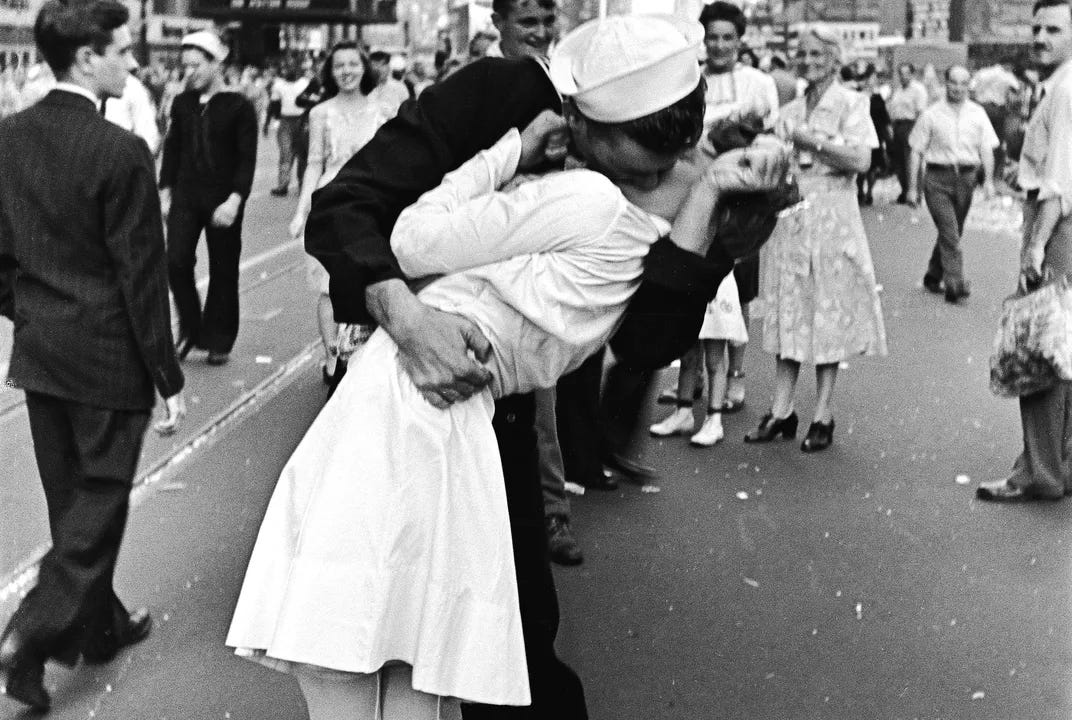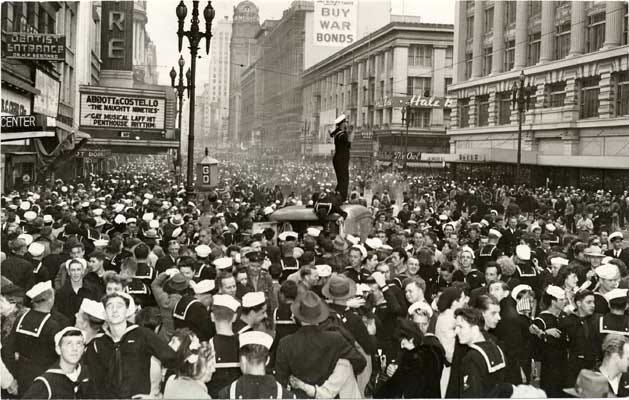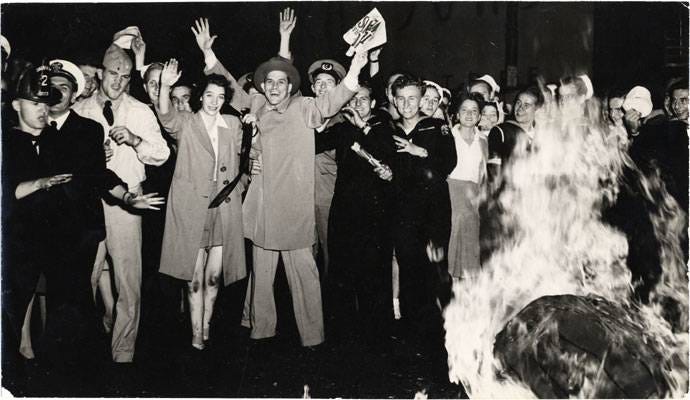
To listen to this story: CLICK HERE
On August 14, 1945, the world erupted in celebration as Japan’s surrender finally brought an end to World War II. Across America, streets filled with euphoria—people danced, horns blared, and flags waved. The party started the same way in San Francisco but quickly spiraled into something unimaginable. Over three chaotic days, from August 14 to 16, the city became the stage for a violent riot that would have left an indelible scar on its history–had it not been covered up. But what’s truly shocking about this story isn’t just the scale of the chaos—it’s who was behind it. The perpetrators weren’t violent street thugs or enemy sympathizers; they were American soldiers and sailors, the very heroes who had just returned from defeating Nazi Germany and Imperial Japan, now unleashing mayhem, rape, and murder on their fellow American citizens.
The city became the stage for a violent riot that would have left an indelible scar on its history–if it had not been covered-up. But what’s truly shocking about this story isn’t just the scale of the chaos—it’s who was behind it.
These men were celebrated as saviors of the world who risked their lives to defend freedom and democracy. Yet, in San Francisco, they quickly turned that image upside down. Starting along Market Street, thousands of servicemen—most of them young, some barely out of their teens—transformed into a drunken, rampaging mob. They smashed store windows, overturned cars, and set fires. But the destruction of property was just the tip of the iceberg. The human toll was staggering: 13 people killed, over 1,000 hospitalized, and an estimated 30 to 40 rapes (at least six women were treated in the hospital–with no police reports taken); eye-witness reports of brutal gang rapes only added to the horror. These weren’t acts of America’s enemies—these were barbaric attacks on American citizens carried out by America’s protectors.
The stories from those three days are gut-wrenching. Joe S. Gyorgy, a 34-year-old Muni inspector, was bludgeoned to death while trying to keep the city streetcars up and running. Stella Morris, a 38-year-old newlywed, was run over by a car on her wedding night, her husband left in a pile beside her. An 80-year-old retired bank clerk, John Batchan, died after being hit over the head with a metal object, a random act of cruelty that snuffed out his life. These victims were innocent people—neighbors, coworkers, ordinary citizens who crossed paths with American heroes gone rogue. It’s a betrayal that’s hard to fathom: men who had just fought for justice abroad coming home to shatter it
Even more shocking is how little was done about it. Despite the bloodshed and brutality, not a single person faced serious consequences. No prosecutions, no military reprimands—nothing. San Francisco’s leaders, including Mayor Roger Lapham, swept the riot under the rug. The newspapers quickly buried the story. A grand jury investigation stopped quicker than it started, and as the San Francisco Chronicle put it decades later, “the city simply tried to pretend the riots never happened.” Victims and their families were left with no justice, their pain silenced to protect the image of the returning troops.
So what drove these men to this madness? Some historians point to the pent-up energy of male youth, the heavy flow of alcohol, and the lingering stress of war—even though many of the perpetrators were never near the front lines. But these explanations don’t erase the shock. As Chronicle reporter Stanton Delaplane wrote on the first night, “A looting, smashing crowd is tearing up Market Street tonight… It is out of hand.” Eyewitnesses described women being gang-raped and violently assaulted in plain sight, with no one stepping in. The mob ruled the city, not being slowed for three full days, until police and military forces finally quelled them with tear gas and fire hoses. Historian Charles Fracchia summed it up grimly: “The only city in the United States that celebrated the end of the war with a riot was San Francisco.” Why that is, people are at a loss to explain. Were these servicemen from the area, or were they from cities across America? I haven’t been able to find an answer to that.
This dark chapter forces us to rethink our use of the word “hero.” These soldiers had just helped win a global war, but in those three days, they became the villains in their own story, attacking the very people they’d sworn to protect. It’s a jarring reminder that heroic acts don’t give one a free pass—that those we put on pedestals often fall hard. Today, the V-J Day riot is largely forgotten, buried deep in the archives, but its lesson still stings: true heroes don’t just win battles—they uphold the values they fight for, even when the war is over. San Francisco’s victory celebration turned into a nightmare, a shock we can’t afford to forget.
Be sure to check out Jon Kinyon’s personal blog: This Dude Thinks He’s a Writer.






